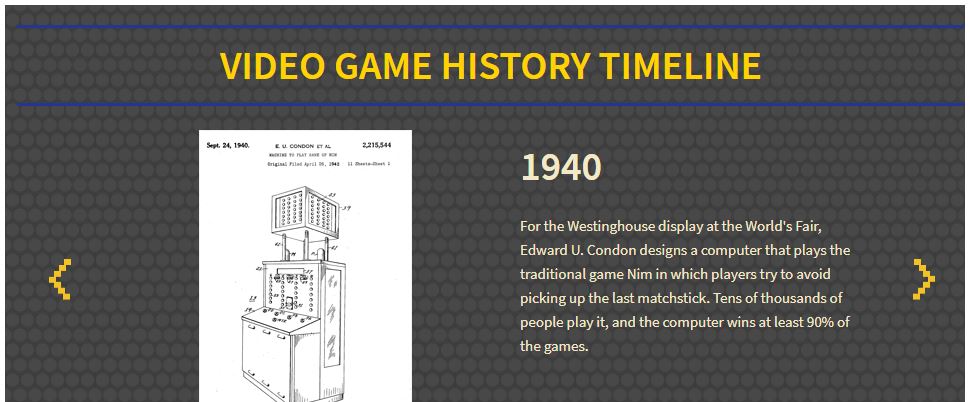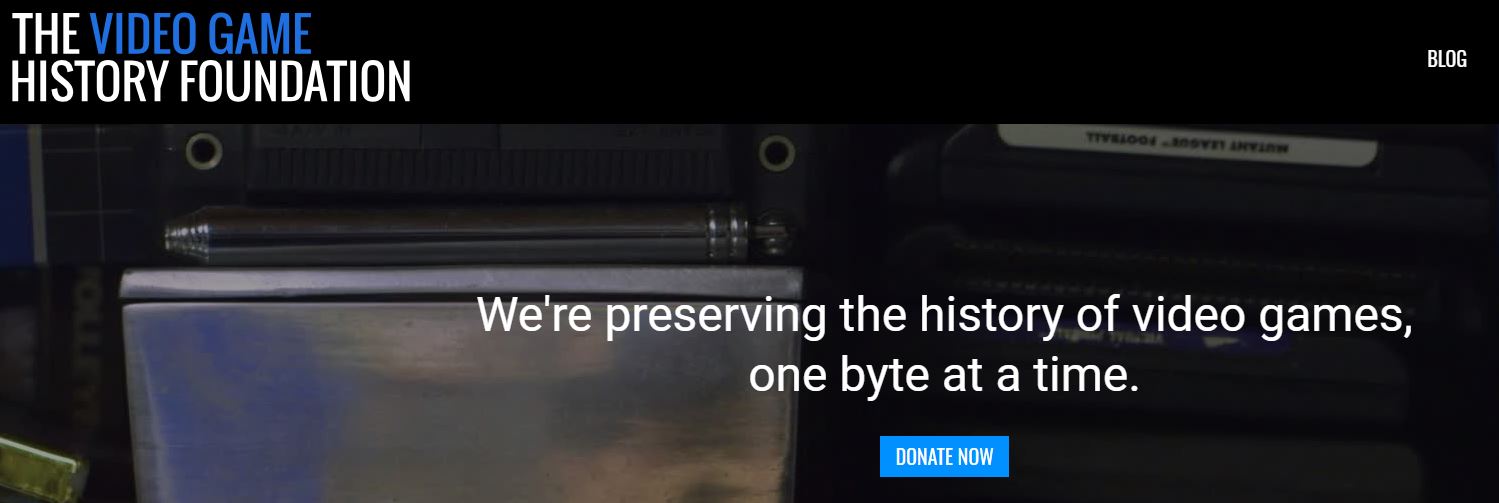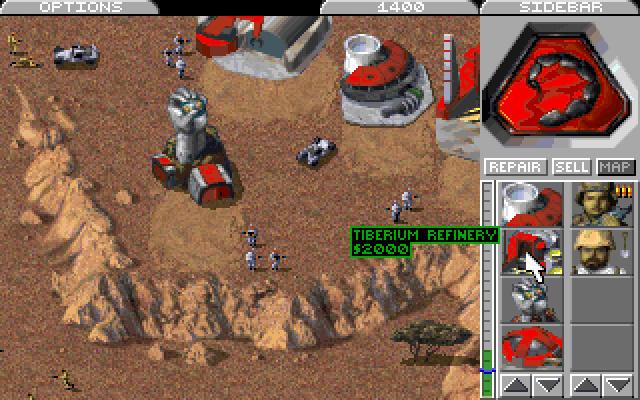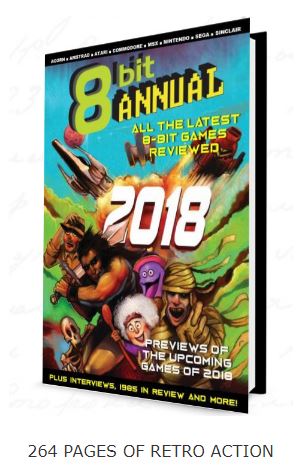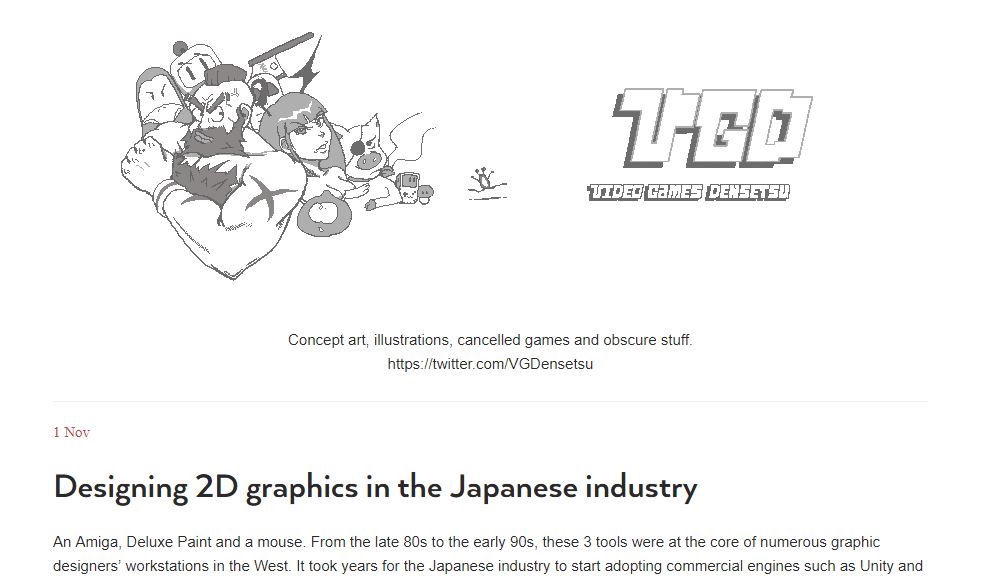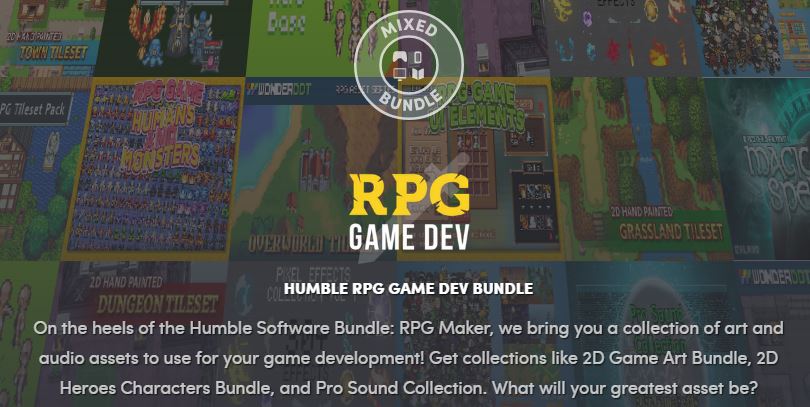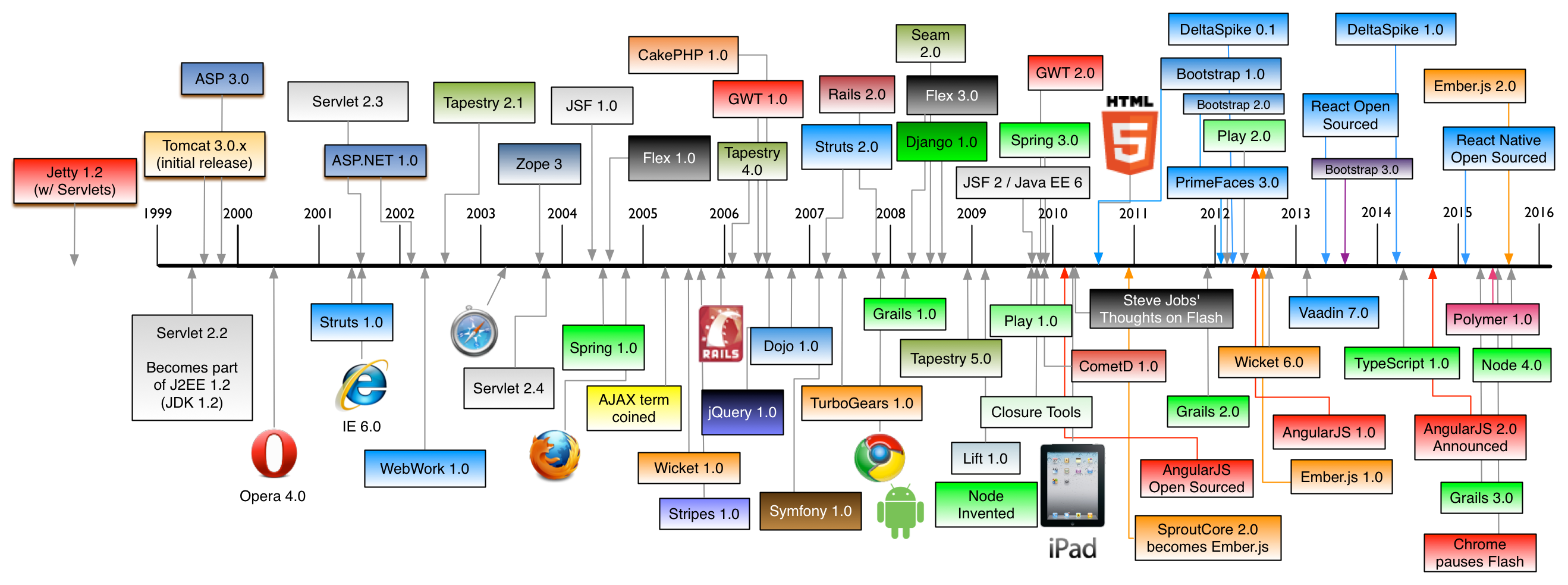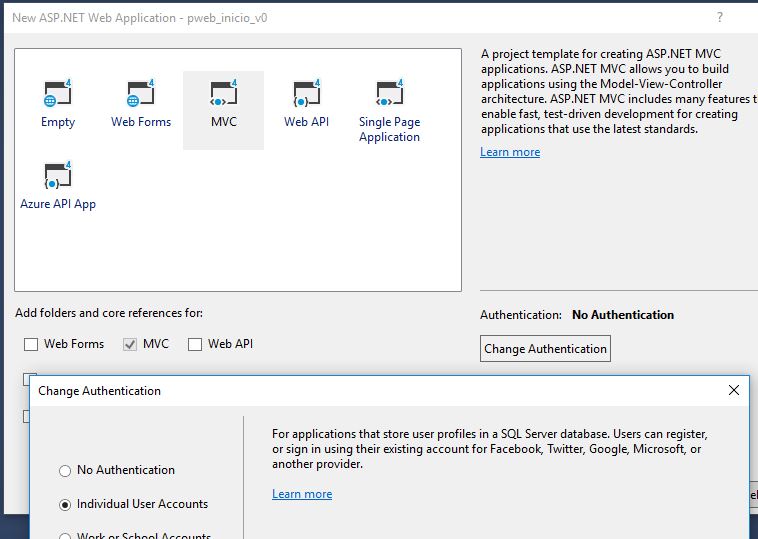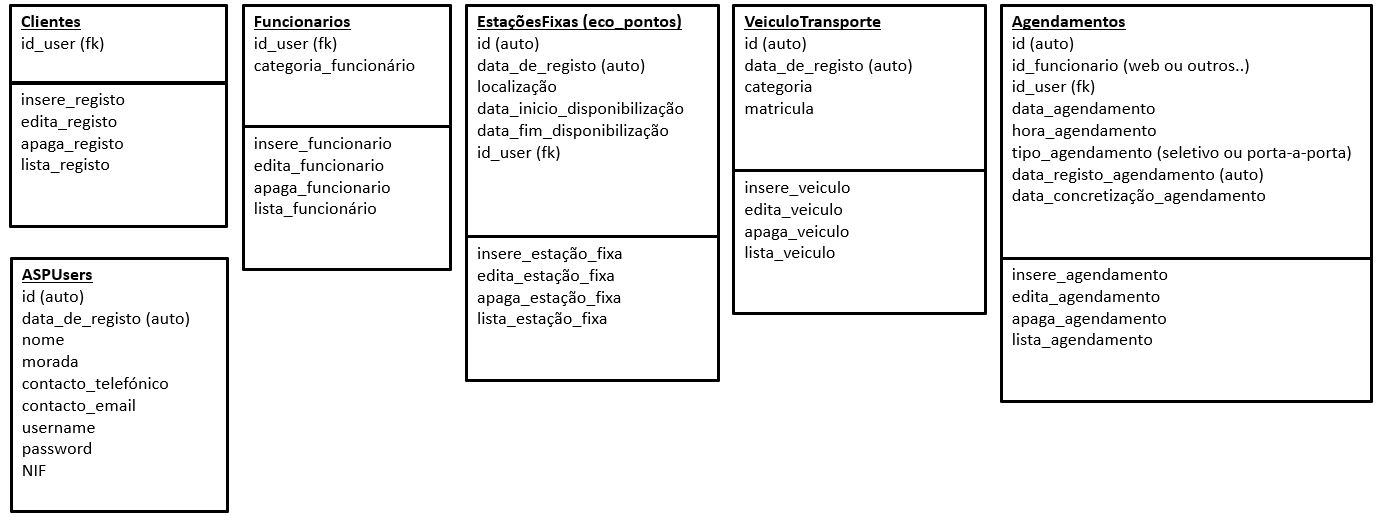Uma história ilustrada sobre o desenvolvimento dos videojogos
É uma interessante contar de histórias acerca do desenvolvimento dos videojogos, deste o ano de 1940 até 2017. A sequência de imagens ilustra os vários anos contendo mesmo a informação técnica que levou à aquisição das patentes.
+infos(fonte da informação): LINK
Video Game History (mais uma história)
Video Game History
Today, video games make up a $100 billion global industry, and nearly two-thirds of American homes have household members who play video games regularly. And it’s really no wonder: Video games have been around for decades and span the gamut of platforms, from arcade systems, to home consoles, to handheld consoles and mobile devices. They’re also often at the forefront of computer technology.
The Early Days
Though video games are found today in homes worldwide, they actually got their start in the research labs of scientists.
In 1952, for instance, British professor A.S. Douglas created OXO, also known as noughts and crosses or a tic-tac-toe, as part of his doctoral dissertation at the University of Cambridge. And in 1958, William Higinbotham created Tennis for Two on a large analog computer and connected oscilloscope screen for the annual visitor’s day at the Brookhaven National Laboratory in Upton, New York.
In 1962, Steve Russell at the Massachusetts Institute of Technology invented Spacewar!, a computer-based space combat video game for the PDP-1 (Programmed Data Processor-1), then a cutting-edge computer mostly found at universities. It was the first video game that could be played on multiple computer installations.
Dawn of the Home Console
In 1967, developers at Sanders Associates, Inc., led by Ralph Baer, invented a prototype multiplayer, multi-program video game system that could be played on a television. It was known as “The Brown Box.”
Baer, who’s sometimes referred to as Father of Video Games, licensed his device to Magnavox, which sold the system to consumers as the Odyssey, the first video game home console, in 1972. Over the next few years, the primitive Odyssey console would commercially fizzle and die out.
Yet, one of the Odyssey’s 28 games was the inspiration for Atari’s Pong, the first arcade video game, which the company released in 1972. In 1975, Atari released a home version of Pong, which was as successful as its arcade counterpart.
Magnavox, along with Sanders Associates, would eventually sue Atari for copyright infringement. Atari settled and became an Odyssey licensee; over the next 20 years, Magnavox went on to win more than $100 million in copyright lawsuits related to the Odyssey and its video game patents.
In 1977, Atari released the Atari 2600 (also known as the Video Computer System), a home console that featured joysticks and interchangeable game cartridges that played multi-colored games, effectively kicking off the second generation of the video game consoles.
The video game industry had a few notable milestones in the late 1970s and early 1980s, including:
The release of the Space Invaders arcade game in 1978
The launch of Activision, the first third-party game developer (which develops software without making consoles or arcade cabinets), in 1979
The introduction to the United States of Japan’s hugely popular Pac-Man
Nintendo’s creation of Donkey Kong, which introduced the world to the character Mario
Microsoft’s release of its first Flight Simulator game
The Video Game Crash
In 1983, the North American video game industry experienced a major “crash” due to a number of factors, including an oversaturated game console market, competition from computer gaming, and a surplus of over-hyped, low-quality games, such as the infamous E.T., an Atari game based on the eponymous movie and often considered the worst game ever created.
Lasting a couple of years, the crash led to the bankruptcy of several home computer and video game console companies.
The video game home industry began to recover in 1985 when the Nintendo Entertainment System (NES), called Famicom in Japan, came to the United States. The NES had improved 8-bit graphics, colors, sound and gameplay over previous consoles.
Nintendo, a Japanese company that began as a playing card manufacturer in 1889, released a number of important video game franchises still around today, such as Super Mario Bros., The Legend of Zelda, and Metroid.
Additionally, Nintendo imposed various regulations on third-party games developed for its system, helping to combat rushed, low-quality software. Third-party developers released many other long-lasting franchises, such as Capcom’s Mega Man, Konami’s Castlevania, Square’s Final Fantasy, and Enix’s Dragon Quest (Square and Enix would later merge to form Square Enix in 2003).
In 1989, Nintendo made waves again by popularizing handheld gaming with the release of its 8-bit Game Boy video game device and the often-bundled game Tetris. Over the next 25 years, Nintendo would release a number of successful successors to the Game Boy, including the Game Boy color in 1998, Nintendo DS in 2004, and Nintendo 3DS in 2011.
The First Console War
Also in 1989, Sega released its 16-bit Genesis console in North America as a successor to its 1986 Sega Master System, which failed to adequately compete against the NES.
With its technological superiority to the NES, clever marketing, and the 1991 release of the Sonic the Hedgehog game, the Genesis made significant headway against its older rival. In 1991, Nintendo released its 16-bit Super NES console in North America, launching the first real “console war.”
The early- to mid-1990s saw the release of a wealth of popular games on both consoles, including new franchises such as Street Fighter II and Mortal Kombat, a fighting game that depicted blood and gore on the Genesis version of the game.
In response to the violent game (as well as congressional hearings about violent video games), Sega created the Videogame Rating Council in 1993 to provide descriptive labeling for every game sold on a Sega home console. The council later gives rise to the industry-wide Entertainment Software Rating Board, which is still used today to rate video games based on content.
In the mid-1990s, video games leaped to the Big Screen with the release of the Super Mario Bros. live-action movie in 1993, followed by Street Fighter and Mortal Kombat over the next two years. Numerous movies based on video games have been released since.
With a much larger library of games, lower price point, and successful marketing, the Genesis had leapfrogged ahead of the SNES in North America by this time. But Sega was unable to find similar success in Japan.
The Rise of 3D Gaming
With a leap in computer technology, the fifth generation of video games ushered in the three-dimensional era of gaming.
In 1995, Sega released in North America its Saturn system, the first 32-bit console that played games on CDs rather than cartridges, five months ahead of schedule. This move was to beat Sony’s first foray into video games, the Playstation, which sold for $100 less than the Saturn when it launched later that year. The following year, Nintendo released its cartridge-based 64-bit system, the Nintendo 64.
Though Sega and Nintendo each released their fair share of highly-rated, on-brand 3D titles, such as Virtua Fighter on the Saturn and Super Mario 64 on the Nintendo 64, the established video game companies couldn’t compete with Sony’s strong third-party support, which helped the Playstation secure numerous exclusive titles.
Simply put: Sony dominated the video game market and would continue to do so into the next generation. In fact, the Playstation 2, released in 2000 and able to play original Playstation games, would become the best-selling game console of all time.
The Playstation 2, which was the first console that used DVDs, went up against the Sega Dreamcast (released in 1999), the Nintendo Gamecube (2001), and Microsoft’s Xbox (2001).
The Dreamcast—considered by many to be ahead of its time and one of the greatest consoles ever made for several reasons, including its capability for online gaming—was a commercial flop that ended Sega’s console efforts. Sega pulled the plug on the system in 2001, becoming a third-party software company henceforth.
Modern Age of Gaming
In 2005 and 2006, Microsoft’s Xbox 360, Sony’s Playstation 3, and Nintendo’s Wii kicked off the modern age of high-definition gaming. Though the Playstation 3—the only system at the time to play Blu-rays—was successful in its own right, Sony, for the first time, faced stiff competition from its rivals.
The Xbox 360, which had similar graphics capabilities to the Playstation 3, was lauded for its online gaming ecosystem and won far more Game Critics Awards than the other platforms in 2007; it also featured the Microsoft Kinect, a state-of-the-art motion capture system that offered a different way to play video games (though the Kinect never caught on with core gamers or game developers).
And despite being technologically inferior to the other two systems, the Wii trounced its competition in sales. Its motion-sensitive remotes made gaming more active than ever before, helping it appeal to a much larger slice of the general public, including people in retirement homes.
Towards the end of the decade and beginning of the next, video games spread to social media platforms like Facebook and mobile devices like the iPhone, reaching a more casual gaming audience. Rovio, the company behind the Angry Birds mobile device game (and, later Angry Birds animated movie), reportedly made a whopping $200 million in 2012.
In 2011, Skylanders: Spyro’s Adventure brought video games into the physical world. The game required players to place plastic toy figures (sold separately) onto an accessory, which reads the toys’ NFC tags to bring the characters into the game. The next few years would see several sequels and other toy-video game hybrids, such as Disney Infinity, which features Disney characters.
The 8th and current generation of video games began with the release of Nintendo’s Wii U in 2012, followed by the Playstation 4 and Xbox One in 2013. Despite featuring a touch screen remote control that allowed off-TV gaming and being able to play Wii games, the Wii U was a commercial failure—the opposite of its competition—and was discontinued in 2017.
In 2016, Sony released a more powerful version of its console, called the Playstation 4 Pro, the first console capable of 4K video output. In early 2017, Nintendo released its Wii U successor, the Nintendo Switch, the only system to allow both television-based and handheld gaming. Microsoft will release its 4K-ready console, the Xbox One X, in late 2017.
With their new revamped consoles, both Sony and Microsoft currently have their sights set on virtual reality gaming, a technology that has the potential to change the way players experience video games.
Sources
‘Spacewar!’ The story of the world’s first digital video game. The Verge.
The First Video Game? BNL.
The Brown Box, 1967–68. Smithsonian.
Inventor Ralph Baer, The ‘Father Of Video Games,’ Dies At 92. NPR.
The Video Game Revolution. PBS.
Video Game History Timeline. Museum of Play.
The Surprisingly Long History of Nintendo. Gizmodo.
How Tetris Helped Game Boy Take Over the World. Gizmodo.
How Sonic Helped Sega Win the Early 90s Console Wars. Kotaku.
Sega and Nintendo Console War: Greatest Moments. Prima Games.
Angry Birds Maker Rovio Reports $200 Million In Revenue, $71 Million In Profit For 2012. Business Insider.
Here’s who won each console war. Venturebeat.
The History Of Gaming: An Evolving Community. TechCrunch.
The History of Video Game Consoles. TIME.
+infos(fonte da informação): LINK
Global Jam 2019
A edição de 2019 da Global Jam, maratona de desenvolvimento de um videojogo, vai decorrer um pouco por todo o país.
Em Portugal já existem alguns espaços que estão de portas abertas para receber os participantes e que são:
Porto (Universidade Lusófona do Porto), Barcelos (Instituto Politécnico do Cavado e do Ave), Leiria (Escola Superior de Tecnologia e Gestão), Lisboa (IADE – Universidade Europeia, Instituto Superior Técnico – Taguspark + Belas-Artes, Universidade Lusófona de Lisboa, Restart Lisboa), e Carnaxide (World Academy)
+infos(Global Game Jam 2019 PT): LINK
Livros de anotações grátis de várias linguagens de programação
Aqui está um site cujos autores desconheço que oferecem PDFs de livros acerca de várias linguagens de programação.
Destaco os seguintes:
Algorithms Notes for Professionals book
Android™ Notes for Professionals book
C Notes for Professionals book
C++ Notes for Professionals book
C# Notes for Professionals book
Entity Framework Notes for Professionals book
Git® Notes for Professionals book
HTML5 Canvas Notes for Professionals book
Java® Notes for Professionals book
JavaScript® Notes for Professionals book
jQuery® Notes for Professionals book
jQuery® Notes for Professionals book
Kotlin® Notes for Professionals book
PHP Notes for Professionals book
TypeScript Notes for Professionals book
+infos(oficial): https://goalkicker.com/
Sex lives and video games (uma exposição)
Vai estar patente em Berlim, mais concretamente no Schwules Museum, uma exposição acerca dos videojogos desenvolvidos sobre o “chapéu/cultura” de LGBTQ. A exposição vai ficar patente até meados de maio de 2019.
+infos(oficial): https://lgbtqgamearchive.com/
+infos(Schwules Museum): https://www.schwulesmuseum.de/
Video Game History Foundation
Aqui está mais um daqueles sites interessantes e a ver se tem pernas para andar. O assunto tem, mas vamos ver se tem força para permanecer e crescer :) Espero que sim.
+infos(Video Game History Foundation): https://gamehistory.org/
COIDEV: conferência latino americana
A COIDEV é uma conferência latino americana acerca do desenvolvimento de videojogos. Normalmente decorre durante o mês de dezembro e existe espaço para a apresentação de projetos, palestras, workshops e tantos outros. A ultima edição de 2018 decorreu na University of Engineering and Technology, no Perú.
+infos(): https://www.coidev.com/
Craftpix, assets para ajudar no desenvolvimento de videojogos
Recursos (assets) que não são todos pagos.. e de vez em quando tem umas coisas gratuitas interessantes.
+infos(craftpix): https://craftpix.net/
Linhas de apoio: Desenvolvimento de Video Jogos!
Existe todos os anos um programa Europeu com vista ao apoio de pequenas editoras de videojogos em Portugal. Este ano o concurso aceita candidaturas até final de fevereiro..
+infos(oficial): LINK
Estatísticas para que te quero?
A leitura de estatisticas deve ser lida com muita calma e com ponderação. Contudo é uma fonte de informação acerca dos caminhos que os gamers apostam, e afinal o que é um videojogo sem os seus gamers?
+infos(Sony PlayStation 4 ): LINK
O desenvolvimento de videojogos em Portugal..
Um texto simples, acerca do estado da nação no desenvolvimento de videojogos em Portugal que foram apresentados para um concurso :)
+infos(Desenvolvimento de videojogos portugueses no bom caminho): LINK
Motores de videojogos, optar por qual?
Post interessante acerca da escolha de um motor de videojogo com a conclusão a apontar para o open source nomeadamente o Godot :)
Vale a pena ler.
+infos(Godot: the Game-Changer for GameDevs): LINK
T-Shirts :)
Sites para se comprarem T-Shirts nices :P
+infos(megaphone): LINK
+infos(Need This Now-USA): LINK
+infos(spreadshirt): LINK
+infos(qwertee): LINK
03_Introdução ao C# (pweb)
Acerca do C#:
arquitectura que faz uso de namespaces (uma classe que contem elementos, e que estes podem ser partilhados com outras classes)
recomendável instalar o ReSharper (https://www.jetbrains.com/)
todos os ficheiros têm extensão de .cs,
c# é case sensitive,
o compilador ignora os espaços vazios,
cada statement de C# termina com ponto e virgula,
using System; //namespace
using System.Collections.Generic;
using System.Linq;
using System.Text;
using System.Threading.Tasks;
namespace csharp1
{
class Program
{
static void Main(string[] args) //existe apenas um
{
string nome;
Console.WriteLine("Olá Mundo!");
Console.WriteLine("Qual o seu nome?");
nome = Console.ReadLine();
Console.WriteLine("Bem vindo {0}", nome);
Console.ReadKey();
}
}
}
estrutura básica de um programa em c#:
tem vários namespace, como é o caso do using System;
contém um unico método chamado de main;
e no exemplo em cima:
vai escrever o Olá Mundo!
o método que faz esta acção é o WriteLine
Este método pertence ao objeto System.Console
Static, porque indica que o método Main pode ser chamado mesmo que não haja instância da classe
Nas variáveis podem ser usados literais: inteiros (L, long), reais (f, float)..
using System;
using System.Collections.Generic;
using System.Linq;
using System.Text;
using System.Threading.Tasks;
namespace chsarp_v0
{
class Program
{
static void Main(string[] args)
{
int numero = 24;
string texto = "Pedro deste lado";
Console.WriteLine($"{texto} {numero}");
Console.ReadKey();
}
}
}
Enumerações (enums) permitem declarar uma lista de constantes
using System;
using System.Collections.Generic;
using System.Linq;
using System.Text;
using System.Threading.Tasks;
namespace chsarp_v0
{
class Program
{
enum DiaFutebol : int
{
sextafeira = 0,
sabado = 1,
domingo = 2
};
static void Main(string[] args)
{
DiaFutebol DiaF = DiaFutebol.sextafeira;
Console.WriteLine($"Dia de futebol {0}", DiaF);
Console.ReadKey();
}
}
}
As estruturas:
using System;
using System.Collections.Generic;
using System.Linq;
using System.Text;
using System.Threading.Tasks;
struct Aviao
{
private string cor;
public Aviao(string cor)
{
this.cor = cor;
}
public string Cor
{
get { return cor; }
set { cor = "verde"; }
}
public string Descricao()
{
return "Cor de um avião = " + cor;
}
}
namespace chsarp_v0
{
class Program
{
static void Main(string[] args)
{
Aviao aviao;
aviao = new Aviao("Preto");
Console.WriteLine(aviao.Descricao());
Console.ReadKey();
}
}
}
Os arrays:
using System;
using System.Collections.Generic;
using System.Linq;
using System.Text;
using System.Threading.Tasks;
namespace chsarp_v0
{
class Program
{
static void Main(string[] args)
{
int[] numeros = {1, 2, 3, 4, 5, 6, 7, 8, 9};
Console.WriteLine("\\-primeira versão:");
for (int i = 0; i < numeros.Length; i++)
{
Console.WriteLine("informacao {0}", numeros[i]);
}
Console.WriteLine("\\-segunda versão:");
foreach (var anda in numeros)
{
Console.WriteLine("informacao {0}", anda);
}
Console.ReadKey();
}
}
}
C&C Remastered
Nem sei o que dizer, mas um dos primeiros jogos que joguei e mais gostei na era dos RTS foram as várias sequelas de Command and Conquer (C&C).
Só parei de jogar porque entretanto não tive mais tempo para tal e porque a surgiram na altura outros jogos com outras histórias como foi o caso do Warcraft e depois o Starcraft. Mas para já as boas noticias. Parece que alguns dos elementos originais da série vão voltar a pegar e fazer um lift do jogo para que seja mais agradável de se ver e jogar nos tempos modernos.
Vamos então ver se vai tudo chegar a bom porto :) espero que sim!!!!
+infos(fonte): LINK
Os prémios (2018) do concurso IndieX
BEST OF THE SHOW
Sword Legacy: Omen
BEST PORTUGUESE GAME
Those Who Remain (trailer)
MOST INNOVATIVE GAME
Pixel Ripped 1989
BEST MULTIPLAYER EXPERIENCE
Pic-A-Boo
BEST ART DIRECTION
She and the Light Bearer
PEOPLE’S CHOICE
The Irrational World of Damien (Shine)
Mais um achado em português
Encontrei um blog que tem como tradição postar noticias acerca de videojogos do ZX Spectrum, em português! :)
Destaco também o arquivo que eles partilham acerca das noticias de jornais sobre videojogos e estas tecnologias .. e sem deixar de lado o jornal A Capital :) todas as sextas ;)
+infos(blog): https://planetasinclair.blogspot.com/
História dos videojogos :) (mais um livro)
Encontrei mais uma referência a um livro acerca de videojogos para “consolas” de 8 bits, onde se inclui o meu favorito, ZX Spectrum. Ainda não é desta que vou comprar já que o preço ronda perto dos 50 euros :(
+infos(oficial): LINK
Um pouco de história..
Um post interessante acerca da história no desenvolvimento gráfico dos videojogos que foram desenvolvidos no Japão por VGDensetsu.
+infos(post): LINK
RPG Maker, (HUMBLE RPG GAME DEV BUNDLE)
A malta da Humble tem até dia 26 de novembro um pack de vários objectos (imagens e sons) para serem usados no desenvolvimento de jogos do tipo RPG. Da lista consta:
7Soul’s RPG Graphics – Sprites
Weapon and Armor Icon Pack
GUI Icons
2D Hand Painted – Grassland Tileset
2D Hand Painted – Town Tileset
2D Hand Painted – Interior Tileset
Animals RPG Sprites
Orcs and Beast SFX Pack
7Soul’s RPG Graphics – UI Pack
2D Top-Down Tile Set
RPG Overworld Tileset
Tiny, Tiny Heroes – Armies
RPG Inventory Icons Pack Vol 1
RPG Items – Retro Pack
Monsters Time Fantasy RPG Sprite Pack
RPG Dungeon Tileset Plus 2 Bonus Characters
Skill Icon Pack
2D Hand Painted – Dungeon Tileset
Medieval Fantasy SFX Pack
Inventory SFX Bundle
2D Game Art Bundle
Cartoon RPG Characters 1
2D Heroes Characters Bundle
7Soul’s RPG Graphics – Icon Pack
Pixel Characters Collection Vol 1
Over 80 characters with animations!
2D Isometric Tile Pack
Pixel Hero Base
Fantasy RPG Tileset Pack
Pixel Effects Collection Vol 1
Pro Sound Collection
Battle RPG Music Pack
Game Music Stingers and UI SFX Pack Pack 2
Magic Spells SFX Bundle
+infos(oficial): LINK
Design e Criação de Jogos em Portugal (por Paulo Gomes)
Amanhã dia 21 de novembro, vai decorrer nas instalações do Instituo Politécnico de Bragança uma palestra acerca do Design e Criação de Jogos em Portugal
Visutal Studio.. para qualquer versão.
Tive a necessidade de instalar o Visual Studio e dei por mim a necessitar de uma ligação à internet suficientemente rápida para não desanimar.
Assim procurei uma alternativa e encontrei uma possivel solução, para uma instalação offline (sem a necessidade de uma ligação à internet)
Para isso precisei de fazer o seguinte:
(1) fazer o download do “push” (web installer) dos ficheiros relativo à versão que preciso:
| Visual Studio Community 2017 | LINK |
| Visual Studio Enterprise 2017 | LINK |
| Visual Studio Professional 2017 | LINK |
| Visual Studio Test Professional 2017 | LINK |
| Visual Studio Community 2017 for macOS | LINK |
| Visual Studio Professional 2017 for macOS | LINK |
| Visual Studio Enterprise 2017 for macOS | LINK |
(2) criar uma pasta com o nome (por exemplo) tempVB
(3) colar lá o ficheiro do web installer, abrir uma janela de CMD para escrever o seguinte comando nessa pasta:
vs_enterprise.exe –layout C:\tempVS –lang en-US
o que vai ser feito é o descarregar os ficheiros para depois se fazer uma instalação local e sem a necessidade da internet.
02_Introdução (pweb)
O ASP.NET:
é uma framework da microsoft para o desenvolvimento de aplicações web e web services;
possibilidade de utilizar várias linguagens: C#, VB.NET, C++;
code-behind: separação do código HTML;
arquitectura de controlos do lado do servidor;
uso do padrão Model-View-Controller (MVC);
a usar o ASP.NET MVC 5.. embora já exista a evolução com o Core 2.0;
Com o ASP.NET surgem vários modelos para a criação de aplicações web:
web forms (é uma transição do desenvolvimento de aplicações de desktop windows para aplicações web),
ASP.NET MVC (em que o MVC é um padrão de arquitectura de desenvolvimento que separa a aplicação em três componentes: Model (manipula regras de negócio, lógica de entradas), Controller (interação com o utilizador e lógica de entrada) e a View (apresentação). Nesta metodologia o Controller é uma classe separada, o que permite a automatização de testes, e os Controllers não estão limitados a uma view especifica. Esta arquitectura apresenta também como vantagens o desempenho e a escalabilidade.

ASP.NET Web pages, semelhante ao PHP, faz uso de modelos de single pages, e do razor view engine (criação dinâmica de páginas)
ASP.NET Web API, framework que permite desenvolver serviços HTTP
ASP.NET SignalIR, permite desenvolver aplicações em tempo real (exemplo: jogos)
01_projeto: a começar (pweb)
O objectivo é começar um projeto de um web site usando a metodologia MVC e fazendo uso do ASP.Net com a Entity Framework, através do méotodo Code First.
Para começar é necessário instalar no Visual Studio 2017:
1) nuget packages
2) entity framework
Depois de instalados é começar o projeto sabendo por onde começar (isto é, conhecer que tipo de dados queremos e como os queremos usar no web site)
Para começar o projecto temos que:

De seguida é necessário ter em conta os dados que achamos nesta altura fundamentais para o que queremos construir.
e transformar isso no nosso modelo de dados
em que surge:
